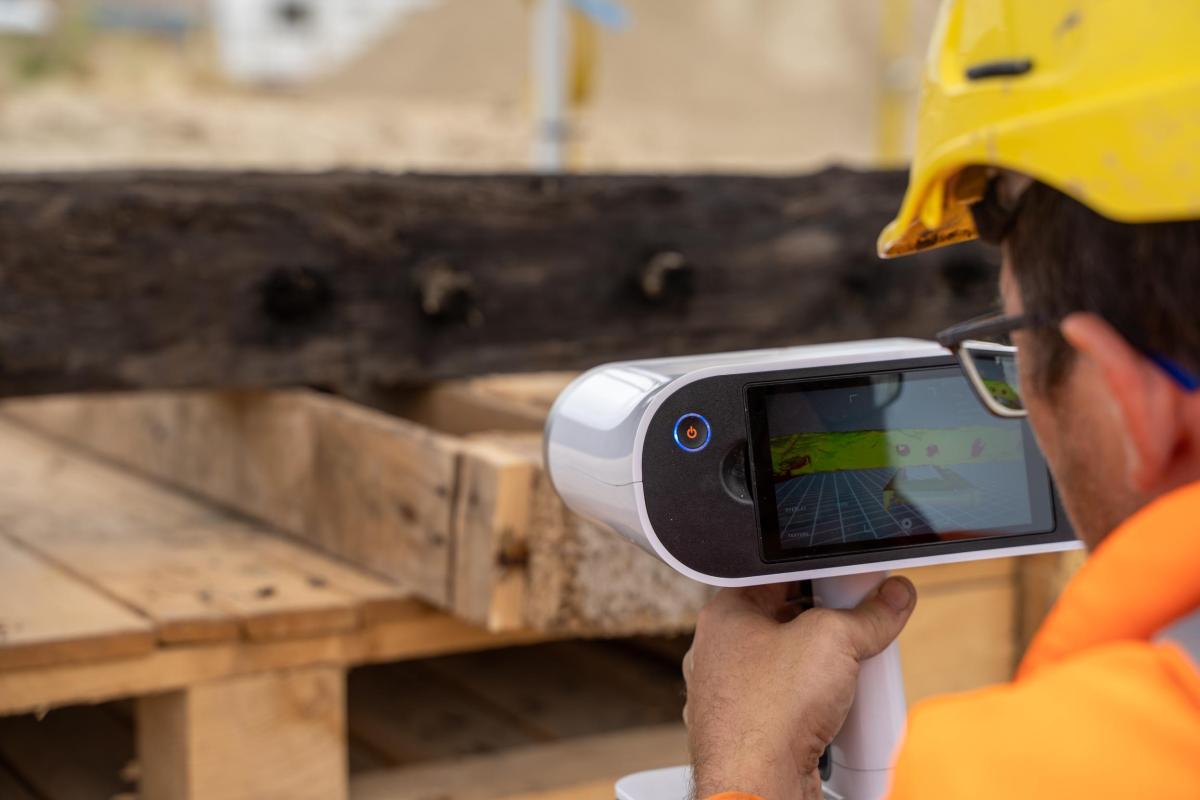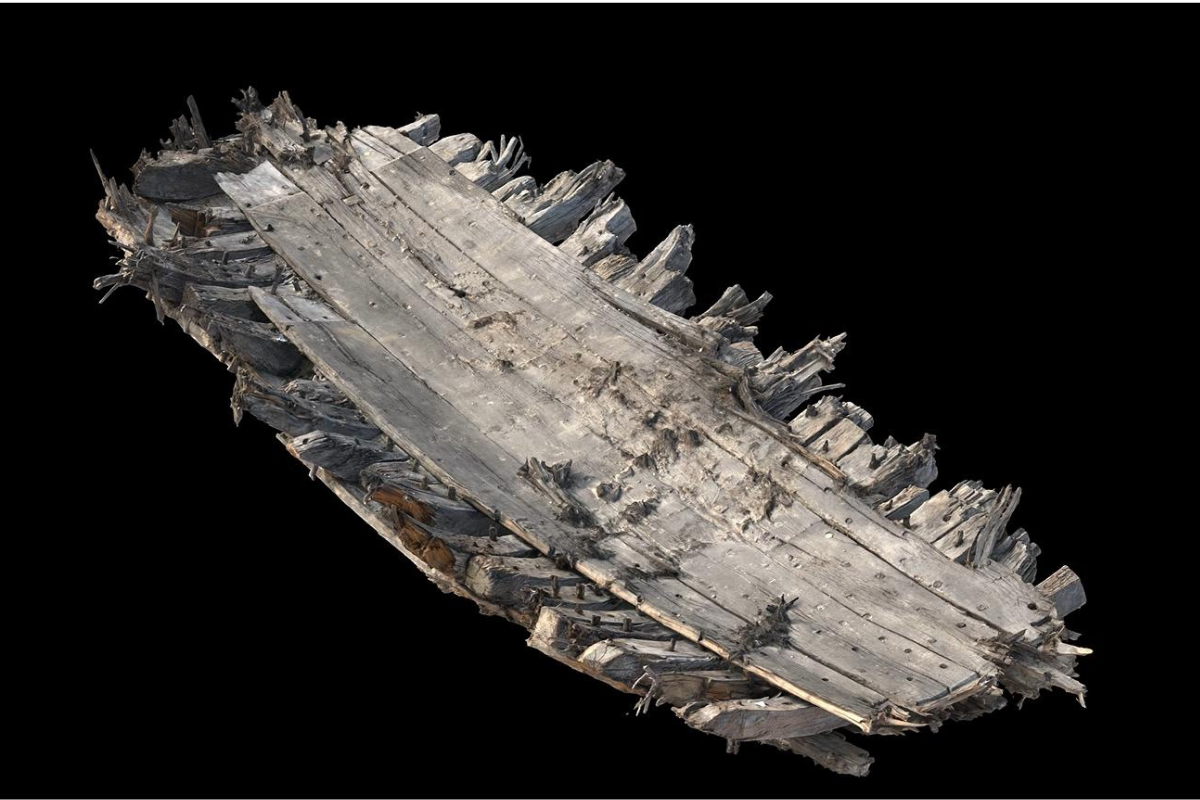In spring 2022, staff at Cemex’s quary on the Dungeness headland in Kent, came across a wooden shipwreck while excavating in the quarry lake for aggregate. In the year since its initial discovery, working for Kent County Council and funded by Historic England, the wreck has been investigated and recorded by archaeologists and discovered to be a rare example of a late 16th-century vessel. To celebrate the discovery of the Dungeness wreck a year on, we are releasing a series of blogs going behind the scenes. In this blog, we look at the recording of the wreck and talk to archaeologist Ben Saunders about the methods used.
Following the initial assessment of the wreck, a team of archaeologists went to record the clearly significant remains in more detail. The timbers were recorded using a mixture of traditional methods of sketches, tape measurements, detailed photography and also scans of the remains were taken using an Artec 3D scanner and photogrammetric survey.


Archaeologists recording timbers using a mixture of traditional drawings, photography, and 3D scanning.
In order to facilitate the handling of timbers during the recording and redeposition stage and allow for the documentation of all elements of the vessel, the large articulated sections of the wreck were disassembled. Archaeologist, Ben Saunders worked, on the site and explained why deconstructing the timbers was vital:
“The vast majority of other surviving ships of this period are either inaccessible for full deconstruction (e.g. subsea wrecks like the Gresham Ship) or are too important to be deconstructed (e.g. the Mary Rose) and so only a part of the story of the ship building can be told. Deconstructing a vessel demonstrates not only the strength in the hull – some of the planks had upwards of 50 trenails (wooden nails) holding them to the floors and futtocks (curved rib-like timbers) of the ship’s framing – but also brings you closer to those who built the ship. Wooden ships come apart in almost a direct mirror to how they went together – you need to find the piece that was put on last and work back from there. In many ways it is like working on a complex urban excavation, where the stratigraphy of the soils is replaced by the building up of the hull from its keel (the central timber running along its base) to its floors to its planking. Deconstruction requirs analytical understanding of how ship timbers work together – there was great thought about where the most effective placement of chocks (wedges) to create a small gap to get a saw in to would be.
It is usually easier to take something apart than it is to build something, and the time it took us to take apart only a small percentage of the overall ship gave us a great appreciation of the time and skill it must have taken to build it. There were also nice personal touches –the wooden plate found in between some frames and the individual adze marks from chipping away some of the tar – which connected us to the builders, likely to be from Kent as several of the team were. It was a very special couple of weeks in the marshes and gravel beaches of Dungeness.”

Ben disassembling a section of the hull.
Over 140 timbers from the ship’s hull were recovered and all were marked with unique identifiers on tags. Once all the timbers were marked, they were removed layer by layer to record the entirety of the structure. The timbers were then carefully cleaned and recorded using either photogrammetry or a laser scanner. Nautical specialists can interpret each individual timber using the 3D scans obtained during the recording phase. Using this method allows us to capture the complex geometries of the timbers and diagnostic features such as fasteners and toolmarks, which can be traced directly onto the timber's digital model.
Interactive 3D model of the main section of the wreck on Sketchfab.


Archaeologist Paolo Croce creating 3D scans of timbers with a Artec scanner, and a still from a 3D model of a large section of hull.
Were there any other finds recorded?
Small finds included a wooden plate, a small ceramic fragment, a piece of scrap leather, and a leather shoe sole. The sole of the shoe was archaeologically assessed by Kevin Trott, a leather specialist at Wessex Archaeology’s Salisbury office, and dated to the 19th-early 20th century. It was recovered (together with small fragments of timbers) during the environmental processing of the sand recovered from the location of the remains. It is likely that this material is intrusive (ie later in date). The absence of any additional artefacts within the bilge (base if the ship) or concreted to the hull, seems to point towards an abandonment of the wreck, possibly as hulk, or the salvaging of material following the wrecking of the vessel on an easily accessible section of coast, but the evidence is too scarce to draw any firm conclusions at this stage.
During the recording phase, cross-sectional samples of some of the timbers were taken to be dated by dendrochronology. Find out in the next blog what the results were!
